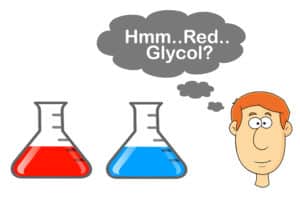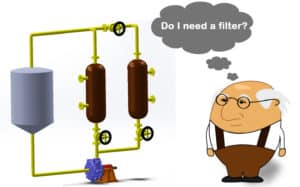Dynalene Glycol Products
Dynalene offers a full line of glycol products that can operate in a temperature range of -60°F to 350°F. Dynalene glycols are available in ½, 1 5, 30, 55, and 265 gallon containers as well as tanker truck loads. Dynalene glycols are offered with or without our specialty additive packages that protect the system from harmful corrosion while stabilizing the pH of the fluid to extend the lifetime of the product and the system. Dynalene glycol heat transfer fluids are made to the highest standards required by our ISO 9001 certification and offer high performances and great value. For more information please call +1 (877) 244-5525 or email at info@dynalene.com. Please choose from the products below.
For our full line of Data Center coolants, both Direct-to-Chip (DTC) and Immersion, please click here.
Dynalene Propylene Glycol
Series
Inhibited propylene glycol
(-50°F to 250°F) / (-46°C to 121°C)
Food grade inhibited propylene glycol
(-50°F to 250°F) / (-46°C to 121°C)
High temperature inhibited propylene glycol
(-50°F to 350°F) / (-46°C to 177°C)
Designed for aluminum systems
(-50°F to 194°F) / (-46°C to 90°C)
Uninhibited propylene glycol
Contact us for Temp. Range
Dynalene Ethylene Glycol Series
Inhibited ethylene glycol
(-60°F to 250°F) / (-51°C to 121°C)
High temperature inhibited ethylene glycol
(-60°F to 350°F) / (-51°C to 177°C)
Aluminum-Safe Inhibited Glycol Heat Transfer Fluid (-51°C(-60°F) to 90°C(194°F)
Designed for aluminum systems
(-60°F to 194°F) / (-51°C to 90°C)
Uninhibited ethylene glycol
Contact us for Temp. Range
Dynalene BioGlycol
Series
Inhibited Corn Derived Glycol
(-50°F to 250°F) / (-46°C to 121°C)
Premixed high temperature inhibited glycol
(-50°F to 350°F) / (-46°C to 177°C)
Unihibited BioGlycol
Contact us for Temp. Range
Frequently Asked Questions
The main difference between the two glycols is that ethylene glycol (EG) is toxic while propylene glycol (PG) is non-toxic and can be purchased in a food grade version in addition to the technical/industrial grade. Another difference is PG has higher viscosity than EG, which means PG could be less efficient than EG, especially at lower temperatures. PG is also more expensive than EG. PG is mainly used in Heating, Ventilation and Air Conditioning (HVAC) as well as food and pharmaceutical process cooling applications, whereas EG is predominantly used in automotive antifreeze/coolant formulations.
In most cases you should mix glycol with water. The goal should be to minimize the amount of glycol in the fluid mixture, while maintaining the needed freeze protection and corrosion inhibitor content. For example, if the freeze protection needed is -20°F then the minimum amount of propylene glycol needed is 46% by volume (47% by wt.). You can consult the glycol technical data sheets provided by the manufacturer to determine the percentage of glycol for the freeze protection needed.
No. When glycols are manufactured they are clear and mostly colorless. The color in a glycol is added for leak detection. Color does not indicate the type of product in the system. The other issue with color is that over time the glycol will change color to darker brown, so the original color may not be apparent.
Inhibitors or corrosion inhibitors have multiple functions in a fluid. The main purpose of the inhibitor is to stop the metallic parts in a system from corroding. The second function of the inhibitor is to extend the life of the coolant itself. Glycol based coolants will degrade over time to acids. The role of the inhibitors is to slow that degradation. Even if you have a stainless steel or non-metallic system you should consider using an inhibitor to protect the fluid. The only time Dynalene recommends not using an inhibitor is when there is galvanized (zinc coated) piping or parts in the coolant loop.
This is a difficult question to answer because of the range of different variables that determine longevity of the coolant. Temperature range, materials of construction, and fluid maintenance are all factors. Dynalene has systems where the glycol has lasted more than 15 years. In certain very high temp systems (> 300°F), the glycol may last only a few years.
The easiest way to determine if something needs to be done with the glycol is to check the pH of the fluid. Normally the pH should be above 8.0, but if it drops below that you should have it tested professionally and adjust, or change the fluid completely. In addition, if you observe severe corrosion (particulates in the fluid) in the interior of the cooling loop then a thorough testing of the fluid is necessary. The glycol manufacturer can recommend any adjustment or change-out of the fluid.
The answer to this question depends on a number of factors including the temperature range, materials of construction, whether the system is open or closed and if it pressurized. These questions are the basis of choosing a fluid because they dictate if you should use a thermal oil (hydrocarbon), a brine (salt solution), a glycol or another chemistry. Once the chemistry is figured out we can move on to other properties like viscosity, thermal conductivity, toxicity, flammability, cost and durability. The best way to pick a fluid for your specific system is to speak with an expert.
Actually, it is not straightforward to call a system open or closed. A truly open system would be a bath that is completely open to atmosphere. A truly closed system would be an air-tight system completely purged of air with no way for it to get in or out. There are a number of different types of systems in between. There are covered baths, which limit the amount of air that comes in contact with the fluid. There are systems with reservoirs that have an air filled head space or a bladder attached to the head space for expansion/contraction. The reason the recommended temperature range varies from open system to closed system is based on vapor pressure (boiling)/evaporation, moisture condensation, and oxidation/degradation.
Aluminum is a great material to use in a heat transfer fluid system; however typical corrosion inhibitor may not be good enough to protect the product. The pH of typical glycol-based heat transfer fluids is too high (> 9.0°F). Aluminum behaves well at a pH of 4.5 to 8.5. You can either adjust the pH of your fluid or add an aluminum corrosion inhibitor.
You can use properly inhibited glycols at high temperatures up to 350°F. Regular inhibited glycols are generally rated up to 250°F. At temperatures higher than 250°F, glycols degrade severely forming acid molecules. However, with proper buffering and corrosion inhibitors a glycol can be used at high temperatures.
It is always good to have a filtration system (in-line or slip-stream) in the heat transfer fluid circulating loop. Fluids over time accumulate debris, corrosion products, and precipitates due to contamination, system corrosion or fluid degradation. If the fluid is not filtered then it may lead to system clogging, reduction in heat transfer rate, and excessive corrosion.
It depends on the type/chemistry of the heat transfer fluid. If your fluid is a glycol then you can check the pH and the concentration of the glycol onsite. A hand-held pH meter and a refractometer can be used for this purpose. However, for the determination of inhibitor concentration, a sample must be sent to the glycol supplier. For hydrocarbon and silicone heat transfer fluids, moisture content by Karl Fisher method and composition analysis by Gas Chromatography can be performed in a laboratory equipped with these instruments.
